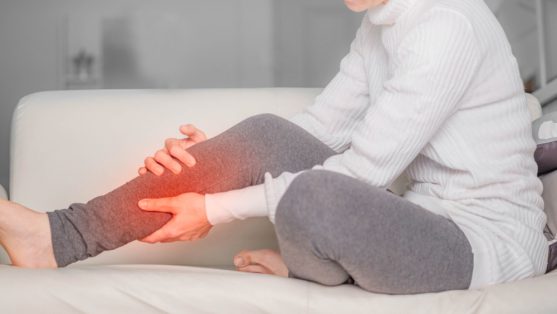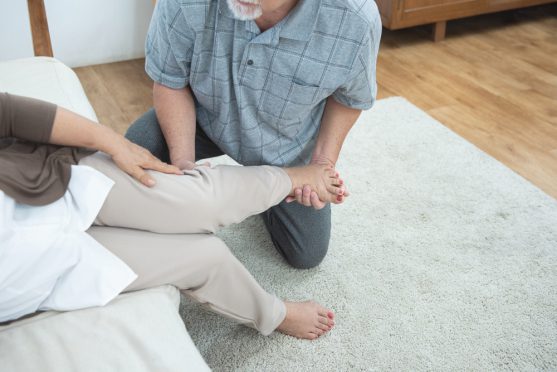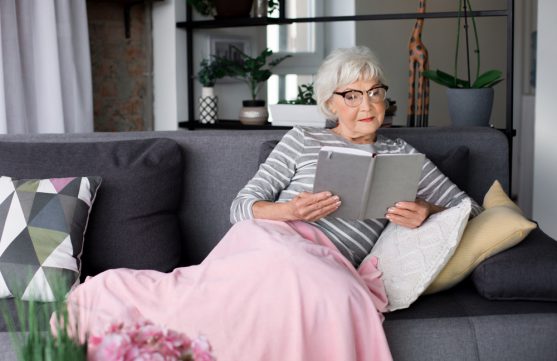Cancer patients may experience leg cramps as a side-effect of their cancer treatment or due to the nature and location of their cancer.
Sometimes, other factors like pre-existing medical conditions or dehydration may also lead to leg cramps. Staying inactive for long durations of time may also cause this condition.
If you have felt a painful tightening of the muscles in your leg, ankle or foot, you may have experienced leg cramps. You might have difficulty moving the leg or foot, as the muscles tend to stiffen up.
We take you through what leg cramps are, the reasons they occur during cancer treatment and 10 easy remedies for it.

What is a leg cramp?
It is the painful cramping or tightening of the muscles in your thigh, calf, ankle or foot.
If you are undergoing treatment for cancer, leg cramps can be sudden and persistent, making the muscles in your leg stiff and difficult for you to move your leg.
Though it lasts only for a few minutes, if it happens at night, it could hamper your sleep.
It is important therefore, to know what to expect during your treatment for cancer.
What are the causes of leg cramps in people who have cancer?
Some cancers can cause leg cramps, especially in the case of tumours that start in the muscle or press on a muscle.
In people undergoing cancer treatment, and already having leg cramps, a few cancers can also worsen the cramps.
The possible side effects of cancer treatment that cause leg cramps can include:
- Certain medications used in chemotherapy, targeted therapy, and immunotherapy
- Some drugs used in hormone therapy such as those for the treatment of breast cancer
- Radiation therapy administered to the lower regions of your body such as the hips and legs
- Medications to treat bone loss
- Having too many white blood cells or treatment given for too few white cells
- Nerve damage due to certain tumours, radiation or cancer surgery
- Certain other health problems unrelated to cancer
Some other conditions that lead to leg cramps can be:
- Growth of tumours surrounding the damaged muscle in the leg
- A spinal cord injury or a pinched nerve that presses upon the nerves in the legs
- The overuse of certain muscles especially during exercise
- Changes in the temperature in your surroundings (house or bedroom) or the weather
- Being inactive or staying in bed for long hours without moving the muscles
- Dehydration as a result of not drinking enough water or liquids
- Lack of blood circulation in the legs and muscles
- Imbalance or change in the levels of electrolytes or minerals in the blood, especially calcium, glucose or sugar, potassium, or phosphorus
- Dialysis in kidney patients. Though the exact cause of leg cramps in those on dialysis is unknown, it is believed to be related to excess fluid removal towards the end of the dialysis session
- Pregnancy

10 ways you can prevent and manage leg cramps better
Though leg cramps are not life-threatening, it can be debilitating. Because it is painful, it can affect your day to day routine and hamper other normal activities.
If you are undergoing treatment for cancer, it can also disrupt your sleep since the leg cramps happen mostly at night.
Leg cramps need not lower your quality of life especially when you are getting the right treatment for your cancer and are on the road to recovery.
Before you try out any of the below remedies, remember to consult your doctor who is the best person to advise you on which ones will work comfortably for you.
- Before you lie down, gently stretch out your legs. Do this a few times to prevent leg cramps from appearing
- Massage your legs gently. Start from the thighs to the calf and down to the ankles. Don’t press down too hard. Use oil or a body lotion to help you massage smoothly.
- Cold and freezing temperatures can bring on leg cramps in some folks. Try and keep yourself warm from head to toe. Wear loose, warm legwear such as woolen stockings and socks. Keep a warm or thermal blanket across your legs. You could also keep a hot water bottle near your legs, under the blanket.
- If you are in bed or sitting for long hours, change your position often and move your legs. Exercise your legs by bending and straightening them from time to time. You can also do this stretching exercise when you are lying down.
- Drink enough water and liquids throughout the day even if it means visiting the washroom often. Keeping yourself well hydrated can prevent cramps to a great extent. However, if the cramps are caused by an imbalance in electrolytes, your doctor will include supplements in your diet to rectify it.

- If you are required to be in bed and the blankets are weighing down on your legs, you can make a bed cradle for the blankets. A bed cradle is a kind of support tied to the end of the bed to hold the weight of the blankets away from your legs but just close enough to keep them warm.

- When you have a cramp or feel one coming, stretch out the tight muscles in your legs. If you are lying down, sit up and stretch out your legs without hurting the muscles too much. For example, if you have a cramp in your calf, walk around to ease the muscles, or point your toes inwards towards the knees.
- Ask your doctor if you can apply a hot or cold pack or towel alternatively to the cramped muscles. Or take a hot bath to relax the muscles. She/he will be able to advise you about the kind of heat and cold you can safely use and for how long you can keep it on your legs.
- If your leg cramps are persistent and painfully uncomfortable to bear, your doctor will prescribe suitable medicines to help prevent or reduce it from occurring as well as muscle relaxants to ease the muscles and manage the pain.
- Eat a potassium-rich diet of bananas, muskmelon, dried apricots, raisins, yogurt (curds), cooked spinach, avocado, and peaches.
When to see your doctor for leg cramps
The last thing you want when you are getting the best treatment for your cancer is leg cramps that cause a lot of pain and discomfort, or symptoms that get worse.
Consult your doctor immediately if the leg cramps:
- Are severe and you can’t move your legs
- Are frequent
- Last for more than 6 to 8 hours at a stretch
- Don’t go away even after stretching, massaging and cold/hot compress
- Cause muscle weakness
- Or if your legs become red, swollen, tender and hot.
Painful leg cramps should be the least problem on your mind especially when you’re getting the best treatment to combat cancer. And if there are simple remedies that you can try out at home yourself, or with the help of your care-giving family, to ease your tight muscles, you must give it a shot.
Your doctor is just a call away to give you the best advice and care to get you back on your feet should you need it.

